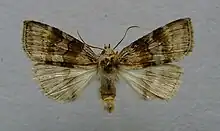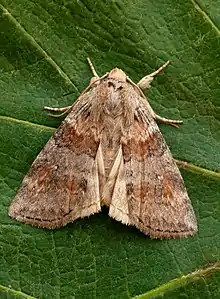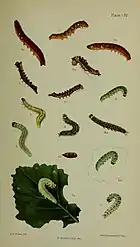Cymatophorina
Cymatophorina is a monotypic moth genus of the family Drepanidae first described by Arnold Spuler in 1908. Its only species, Cymatophorina diluta, the oak lutestring[1] or lesser lutestring,[2] was described by Michael Denis and Ignaz Schiffermüller in 1775.[1] It is found in much of Europe,[3] with subspecies Cymatophorina diluta hartwiegi occurring in Britain.[1]
| Cymatophorina | |
|---|---|
 | |
 | |
| Scientific classification | |
| Kingdom: | |
| Phylum: | |
| Class: | |
| Order: | |
| Family: | |
| Genus: | Cymatophorina Spuler, 1908 |
| Species: | C. diluta |
| Binomial name | |
| Cymatophorina diluta (Denis & Schiffermüller, 1775) | |
| Synonyms | |
| |
The wingspan is 33–36 mm. The species is univoltine.[1][4] Adults are on wing between late July and early October,[4] depending on location. Subspecies Cymatophorina diluta hartwiegi flies in August and September.[1]

Fig. 5 larvae after final moult
The larvae feed on the leaves of oak trees.
References
- "65.014 BF1658 Oak Lutestring Cymatophorina diluta ([Denis & Schiffermüller], 1775)". UKMoths. Retrieved 18 August 2018.
- Savela, Markku. "Cymatophorima diluta (Denis & Schiffermüller, 1775)". Lepidoptera and Some Other Life Forms. Retrieved 18 August 2018.
- "Distribution Table Cymatophorina diluta". Fauna Europaea. Archived from the original on September 28, 2006. Retrieved 19 March 2017.
- "Cymatophorina diluta ([Denis & Schiffermüller], 1775)". Catalogue of the Lepidoptera of Belgium. Retrieved 18 August 2018.
This article is issued from Wikipedia. The text is licensed under Creative Commons - Attribution - Sharealike. Additional terms may apply for the media files.